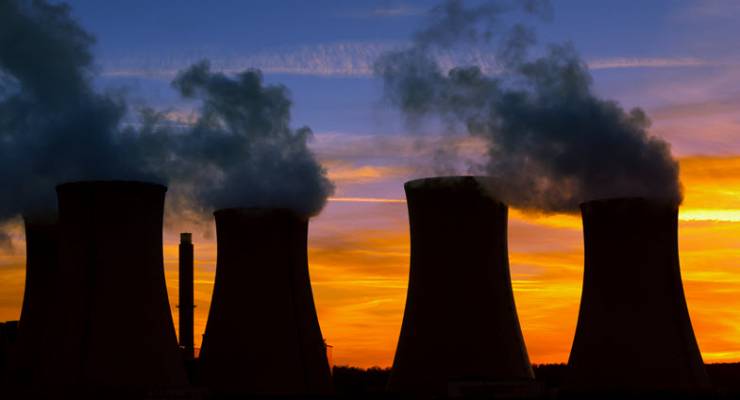
Earlier this month, Minister for Energy and Emissions Reduction Angus Taylor announced the first federal parliamentary inquiry into nuclear power in over a decade.
Considering his track record in the portfolio — which includes floating public funds for the Vales Point coal plant and fudging our Paris commitments — you’d be forgiven for seeing Taylor’s thought bubble as the latest stalling tactic before finally getting around to the emissions reduction Australia has ignored for six years.
But is a nuclear energy industry in Australia really so far-fetched? Crikey examines why it’s never happened, and the voices for and against the push in 2019.
Why did Australia never go nuclear?
Half the problem of developing nuclear plants in 2019 is that we’d have to start from scratch. While some countries ran with the technology from the 1950s, Australia instead went with low-cost coal and gas.
“You need to remember at the earliest days of the nuclear age, we tested nuclear weapons in this country on the Australian mainland, so we weren’t inherently against nuclear energy,” says Professor Michael Brear, director of the Melbourne Energy Institute at the University of Melbourne.
While substantial nuclear subsidies make exact economic comparisons hard to quantify, Brear notes that, without climate change as any kind of policy driver, coal plants easily won out over nuclear.
There were thought bubbles, of course. SA premier Thomas Playford announced vague plans for a plant at Upper Spencer Gulf in 1952. NSW would come closer in 1969 with a 500MW nuclear power station proposed for the Jervis Bay Territory, 200km south of Sydney; it faced local opposition and eventually fell through.
The next few decades saw more failed domestic attempts at generation, a growth of the technology in countries like France, US, China and Russia, an increase in uranium exports in the Northern Territory, South Australia and Western Australia (Australia is now the third largest exporter globally) and a spike in anti-nuclear politics. A poll following the 1979 Three Mile Island nuclear plant accident in the US found overwhelmingly negative public sentiment. Thanks to a Conservation Act amendment, nuclear generation has been banned at the federal level since 1999.
Still, the Coalition has been a fan since the early days. John Howard both supported lifting the ban and, through the 2006 Switkowski report, established that nuclear could compete with coal if Australia introduced some form of carbon pricing. While that climate policy enjoyed bipartisan support for a moment, it’s an ironic qualification considering where the Coalition stands today.
What’s different now?
Establishing nuclear plants is still overwhelmingly expensive — a CSIRO and Australian Energy Market Operator report last year indicated it would be the most expensive form to build, even compared to renewables with storage.
However, the urgent need to slash global carbon emissions has seen a range of local and international climate scientists join the call for nuclear alongside far-right climate sceptics like Tony Abbott, Clive Palmer and the Mineral Council.
“Nuclear electricity is a near zero greenhouse gas emission form of electricity generation,” Brear says. “That’s a fact. The French have demonstrated that you can run an entire nation’s electricity system off it; that’s another fact. Whether or not that’s cost effective and more affordable than alternatives, that’s certainly yet to be seen.”
South Australia, by far the country’s best performer for energy transition, considered nuclear power in a 2016 royal commission. It found that even with a carbon price, neither large-scale nor modular reactors would be economically viable before 2050. It did, however, call for the federal moratorium to be lifted.
The Australian Nuclear Association told Crikey that the royal commission failed to consider economic cases in other states.
Still, building a nuclear industry as as response to climate change makes little sense when Australia is long overdue in slashing emissions. The country does not have the decades it would take to win the public over, gain approvals, find sites, develop the industry and build plants. This would put us far beyond the Intergovernmental Panel on Climate Change’s all-important 2030 deadline.
As the Climate Council notes, wind and solar farms take just one to three years to build, can “power our country 500 times over”, do not produce radioactive waste, and do not require negotiating with a population that, as it stands, is only slightly receptive to nuclear generation — as long as it’s in areas not in their backyard.
Brear does, however, argue there is a case for considering the technology further down the track. “If we have an urgent need to achieve abatement; we have to do renewables, amongst other things, right now… [But] it might be that, when we get closer to the mid-century, that nuclear plants developed elsewhere are affordable and are sufficiently safe and reliable for us to integrate into our system.
“It would be poor planning if today we ruled out ever having nuclear, but similarly it would be poor decision making today to commit to nuclear… Let’s see what the inquiry shows up.”
Will Australia ever get on board with nuclear energy? Send your comments to boss@crikey.com.au. Please include your full name.








Crikey is committed to hosting lively discussions. Help us keep the conversation useful, interesting and welcoming. We aim to publish comments quickly in the interest of promoting robust conversation, but we’re a small team and we deploy filters to protect against legal risk. Occasionally your comment may be held up while we review, but we’re working as fast as we can to keep the conversation rolling.
The Crikey comment section is members-only content. Please subscribe to leave a comment.
The Crikey comment section is members-only content. Please login to leave a comment.